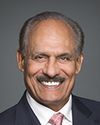Canada works with a lot of multilateral organizations, on both the foreign policy and international development side. There are a number of steps that we take to ensure that the funding we provide is managed effectively and achieves value for money.
If you go on the development side, for example, and you look at specific institutions, Canada often sits on the board of governors of those institutions to help set the strategic direction, to be part of the oversight mechanisms of those organizations, and to examine the audit and inspection functions to make sure that funds are safeguarded.
We do due diligence, as well, on all of those multilateral organizations. That robust due diligence framework that was asked about previously—how do we know our money is well spent?—applies to the funds that we spend with multilateral organizations.





